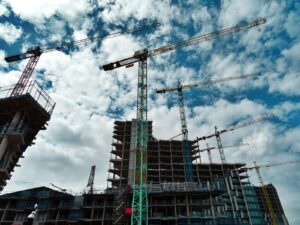The Architecture, Engineering, and Construction industry has never been short on challenges. Whether it’s complex regulations, shrinking margins, or pressure to deliver faster, the demands keep growing.
But with those challenges come opportunities. Opportunities to rethink how the industry works. To improve quality, cut waste, boost collaboration, and build smarter.
Progress doesn’t have to mean revolution. It starts with small, deliberate shifts in how we think, plan, and work together.
Here are seven ways to move the AEC industry forward.
1. AI – Let technology do the heavy lifting
AI in AEC is changing what’s possible. It’s not about replacing professionals, it’s about enhancing what they can do. Think about the tasks that slow teams down or create bottlenecks. Estimating. Scheduling. Document control. AI can support all of it, with speed and precision that manual processes struggle to match.
Examples already in use:
- Automating clash detection and design validation
- Generating real-time risk insights based on past projects
- Analysing materials data for cost and carbon decisions
- Speeding up compliance and drawing review
Adoption is still patchy, but that’s changing fast. The firms and teams willing to experiment with AI will set the pace for the rest of the industry.
2. Design with delivery in mind
Design that looks good on screen but fails on site is still too common.
That gap between concept and construction wastes time and money. It also creates friction between design teams and builders. To move forward, those two groups need to be closer from the start.
This means early contractor involvement, design reviews that consider logistics and sequencing, more practical details in drawings, not just visuals, and using 3D models for both design intent and build planning.
A design that’s easy to build isn’t a compromise. It’s a smarter outcome for everyone involved.
3. Break down the silos
The old structure of separate teams passing work along in a linear chain doesn’t fit today’s projects.
Collaboration is critical, not just between disciplines, but across companies, supply chains, and project phases. Projects benefit when planners, engineers, architects, and contractors work as one team with shared outcomes.
Breaking down silos also means better information flow, fewer misunderstandings, and more accountability and ownership at every stage.
This shift isn’t just cultural. It’s practical. Stronger collaboration reduces rework, keeps things moving, and ultimately produces better buildings and infrastructure.
4. Commit to continuous learning
No one enters this industry with all the knowledge they’ll ever need. Things change too fast for that.
Digital tools evolve. Materials improve. New regulations appear. And client expectations don’t stand still.
To stay relevant and capable, the entire workforce needs access to regular learning, whether it’s technical, digital, or soft skills like communication and problem-solving.
This doesn’t mean endless formal training. It can look like:
- Short, focused internal workshops
- Peer-to-peer learning across teams
- Time to trial and reflect on new methods
- Bringing in specialists to share real project insights
A learning culture builds resilience. It means teams are ready for whatever comes next, not just what worked last time.
5. Focus on performance, not just compliance
Too many projects are considered “done” when they hit practical completion. But how do they perform a year later? Five years later?
Whether it’s energy use, comfort, durability, or maintenance, performance often gets overlooked in favour of just meeting the brief.
That mindset has to shift. Buildings and infrastructure should deliver long-term value, not just pass inspections.
This means designing for lifecycle outcomes, not just short-term metrics. And it means following up after handover to see how things are really working, then using that knowledge to improve the next job.
6. Share what works (and what doesn’t)
There’s still a reluctance in parts of the AEC sector to openly share processes, tools, or lessons learned. That holds everyone back.
The industry gets stronger when ideas are shared, whether it’s a new workflow, a clever workaround, or a warning about what to avoid next time.
This can happen in lots of ways:
- Industry forums and working groups
- Open data standards and model templates
- Cross-sector mentoring and guest lectures
- Project debriefs that get published, not buried
Progress speeds up when we stop keeping knowledge behind closed doors.
7. Raise the bar for project leadership
A lot of industry pain points come down to poor leadership on projects. Not just at the top, but throughout teams.
Leadership in AEC should mean:
- Clear communication across all parties
- A calm, problem-solving approach to conflict
- Respect for everyone’s role, from site to studio
- Holding the line on quality and safety, no matter the pressure
Good project leadership makes work smoother. Great leadership helps raise standards across the industry. It’s something every firm, no matter its size, can commit to improving.
What Happens Next Is a Choice
The industry doesn’t move forward on its own. It moves when people decide to do things better.
AI is one part of that. So is stronger design collaboration, as well as sharing knowledge, improving leadership, and focusing on long-term outcomes.
Change doesn’t need to be dramatic or perfect. But it does need to start, project by project, team by team, decision by decision.

